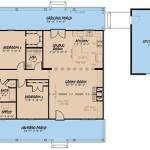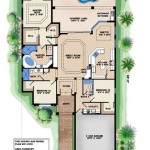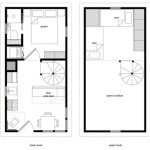How To Make a Simple Floor Plan In AutoCAD
Creating a simple floor plan in AutoCAD is a fundamental skill for architects, interior designers, and drafters. This tutorial will guide users through the process, explaining the essential steps involved in creating a basic 2D representation of a floor plan using AutoCAD.
Setting Up the Drawing
Before beginning to draw, it is crucial to properly configure the drawing environment. This involves setting the units, drawing limits, and layers. Units should be consistent with the intended scale of the floor plan (e.g., feet, inches, or millimeters). Setting the drawing limits defines the working area and prevents the drawing from extending beyond the intended boundaries. Perhaps most importantly, organizing elements into layers allows for better control and management of the different components of the floor plan, such as walls, doors, windows, and furniture.
To set the units, type "UNITS" in the command line and press Enter. Select the appropriate units and precision. To define the limits, type "LIMITS" and specify the lower-left and upper-right coordinates of the drawing area. Finally, access the Layer Properties Manager by typing "LAYER" or clicking the Layer Properties button in the ribbon. Create new layers for different elements of the floor plan, assigning appropriate colors and line types to each.
Drawing Walls
Walls form the basic structure of a floor plan. AutoCAD offers various tools for drawing walls, including the "LINE" command for simple straight walls and the "POLYLINE" command for more complex wall configurations with varying thicknesses. The offset command can then be used to create parallel lines representing the wall thickness. Accurately defining wall lengths and widths is essential for creating a realistic and scaled floor plan.
To draw a wall using the "LINE" command, type "LINE" in the command line and specify the start and endpoint of the wall segment. Repeat this process to create connected wall segments. For walls with varying thicknesses, the "POLYLINE" command offers more flexibility. Type "PLINE" and specify the width of the polyline to represent the wall thickness. Then, draw the wall outline by clicking points along the desired path. To create parallel lines for wall thickness using the offset command, type "OFFSET" and specify the offset distance and the side on which to create the offset line.
Adding Doors and Windows
Once the walls are in place, the next step is to add doors and windows. AutoCAD provides specific blocks or symbols representing various door and window types. These blocks can be inserted into the drawing and positioned within the wall lines. Alternatively, doors and windows can be represented using lines and arcs, offering more customization and control over their appearance. Ensure accurate placement and sizing of these elements within the wall openings.
To insert a pre-defined block for a door or window, type "INSERT" and select the desired block from the library. Specify the insertion point and the scale factor. If custom shapes are required, use the "LINE," "ARC," and "CIRCLE" commands to create the desired door or window representation. Ensure that the dimensions of the doors and windows are accurate and correspond to the overall scale of the floor plan.
Adding Dimensions and Text
Clear and accurate dimensions are crucial for any floor plan. Use the dimensioning tools in AutoCAD to add dimensions to walls, doors, windows, and other elements. This provides essential information for anyone interpreting the plan. Additionally, incorporate text annotations to label rooms, indicate areas, or provide other relevant information. Use a consistent text style and size throughout the drawing for a professional appearance.
Access the dimensioning tools by clicking the "Annotate" tab in the ribbon. Choose the appropriate dimension type, such as linear, aligned, or angular, depending on the element being dimensioned. Click the points to define the dimension lines. To add text, use the "TEXT" command. Specify the insertion point, height, and rotation angle of the text. Input the desired text and press Enter.

How To Draw Floor Plans In Autocad Edrawmax

Autocad Simple Floor Plan For Beginners 1 Of 5

How To Draw Floor Plans In Autocad Edrawmax

Making A Simple Floor Plan In Autocad Part 1 Of 3

Making A Simple Floor Plan In Autocad Fantasticeng

Simple Floor Plan Design Autocad File Free Cadbull

How To Make House Floor Plan In Autocad Fantasticeng

How To Draw Autocad Floor Plan Cad Cam Blog

Making A Simple Floor Plan In Autocad Part 3 Of

How To Draw Floor Plans In Autocad Edrawmax
Related Posts








